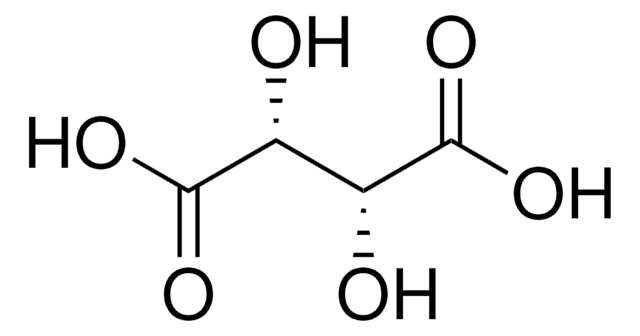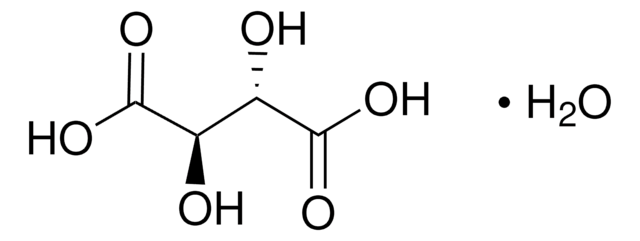Kluczowe dokumenty
T1807
L-(+)-Tartaric acid
BioXtra
Synonim(y):
(2R,3R)-(+)-Tartaric acid, L-Threaric acid
About This Item
Polecane produkty
gęstość pary
5.18 (vs air)
Poziom jakości
linia produktu
BioXtra
Próba
≥98%
Formularz
powder
temp. samozapłonu
797 °F
zanieczyszczenia
≤0.002% Phosphorus (P)
≤0.1% Insoluble matter
pozostałość po prażeniu
≤0.1%
mp
170-172 °C (lit.)
rozpuszczalność
H2O: 1 M at 20 °C, clear, colorless
ślady anionów
chloride (Cl-): ≤0.05%
sulfate (SO42-): ≤0.05%
ślady kationów
Al: ≤0.002%
Ca: ≤0.005%
Cu: ≤0.0005%
Fe: ≤0.005%
K: ≤0.005%
Mg: ≤0.001%
NH4+: ≤0.05%
Na: ≤0.005%
Pb: ≤0.001%
Zn: ≤0.0005%
ciąg SMILES
O[C@H]([C@@H](O)C(O)=O)C(O)=O
InChI
1S/C4H6O6/c5-1(3(7)8)2(6)4(9)10/h1-2,5-6H,(H,7,8)(H,9,10)/t1-,2-/m1/s1
Klucz InChI
FEWJPZIEWOKRBE-JCYAYHJZSA-N
Szukasz podobnych produktów? Odwiedź Przewodnik dotyczący porównywania produktów
Opis ogólny
Zastosowanie
- w sterylizowanym filtrem syntetycznym soku winogronowym do fermentacji biesiadnej
- w eksperymencie krystalizacji
- w celu zbadania wpływu stereospecyficznych oddziaływań między stereoizomerami kwasu winowego i białkami podczas krystalogenezy
Działania biochem./fizjol.
Hasło ostrzegawcze
Danger
Zwroty wskazujące rodzaj zagrożenia
Zwroty wskazujące środki ostrożności
Klasyfikacja zagrożeń
Eye Dam. 1
Kod klasy składowania
11 - Combustible Solids
Klasa zagrożenia wodnego (WGK)
WGK 1
Temperatura zapłonu (°F)
302.0 °F - closed cup
Temperatura zapłonu (°C)
150 °C - closed cup
Środki ochrony indywidualnej
dust mask type N95 (US), Eyeshields, Gloves
Wybierz jedną z najnowszych wersji:
Masz już ten produkt?
Dokumenty związane z niedawno zakupionymi produktami zostały zamieszczone w Bibliotece dokumentów.
Klienci oglądali również te produkty
Nasz zespół naukowców ma doświadczenie we wszystkich obszarach badań, w tym w naukach przyrodniczych, materiałoznawstwie, syntezie chemicznej, chromatografii, analityce i wielu innych dziedzinach.
Skontaktuj się z zespołem ds. pomocy technicznej





